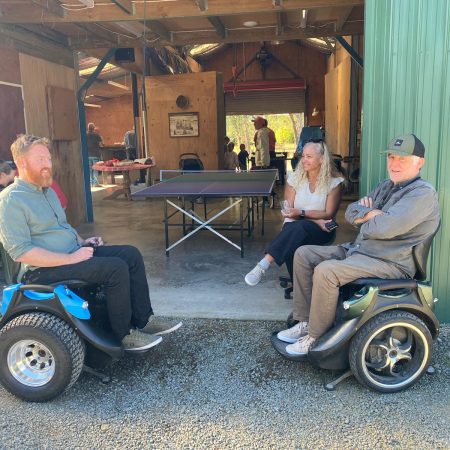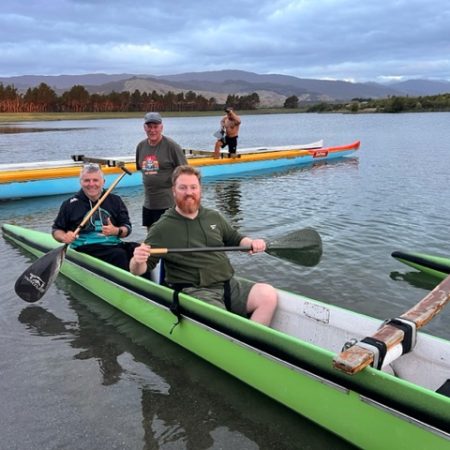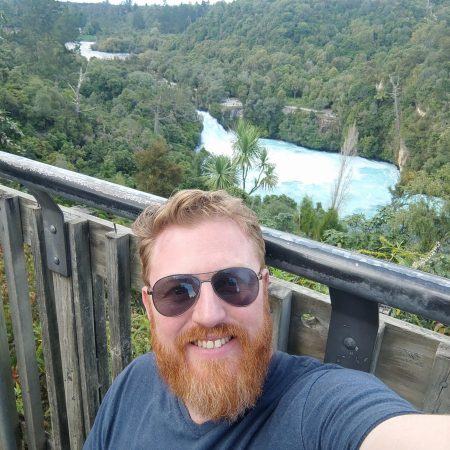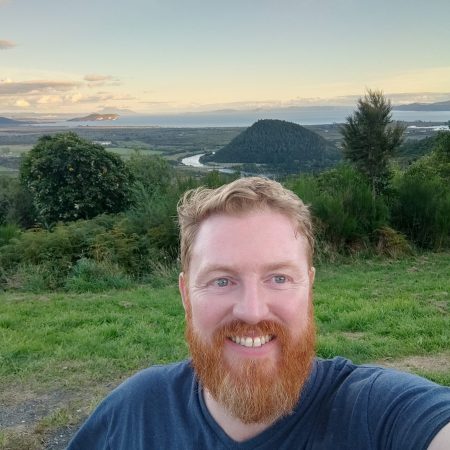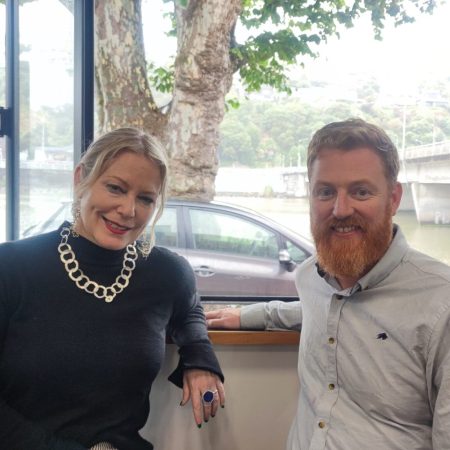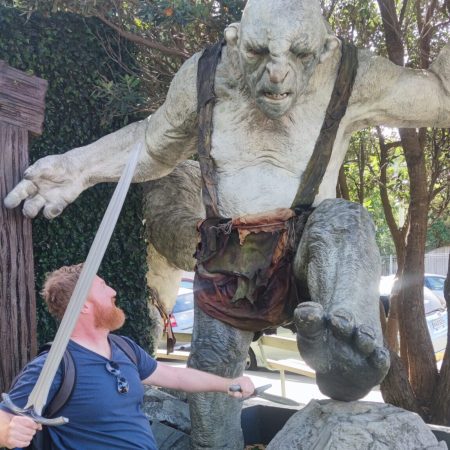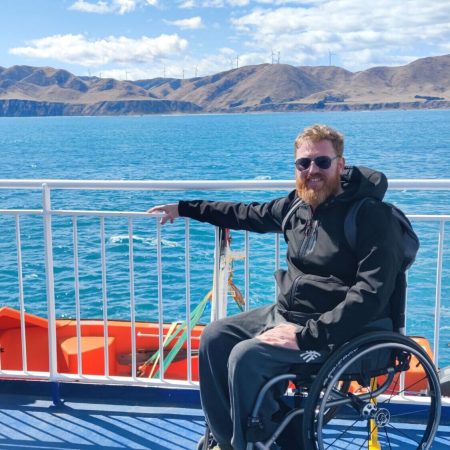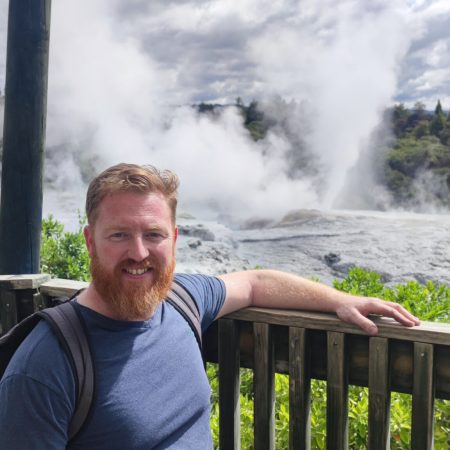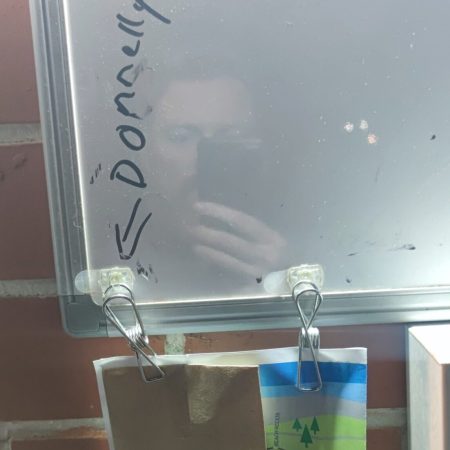When one door closes, another door opens. So when I enquired at the tourism office about wheelchair accessibility on intercity buses leaving Auckland and was told that they aren’t, I started to think about other options. I glanced to my left at the shelf full of brochures and one caught my eye. A car rental company. Aha, I thought. Another door.
My original plan was to take public transport for most of my journey. The new plan was another road trip, driving from Te Ika-a-Māui to Te Waipounamu, which are the Maori names for the north and south island here in Aotearoa New Zealand.
There are so many options when I started looking through rental options. Surprisingly a company that offers options with fixed hand controls. These are great. Easier to drive than the removable hand controls that I have with me and what I have in my car at home so a setup that I’m used to. They did however come in more expensive than other car rental companies and as I needed a bigger car because of my suitcase, wheelchair and power assist, it wasn’t going to be cost effective to spend money on a car of the size I needed with fixed hand controls from them.
Instead, I shopped around and found a good deal with Omega car rental. A slightly older SUV (Toyata RAV 4) which offered me the space I needed at a reasonable price and not an additional amount to collect from Auckland and drop off in Christchurch, something that most companies add to the total. Based near the airport, it wasn’t the most accessible location from where my hotel was and meant I had a 5:30am alarm so I could get on the road at a reasonable time.
Getting across the city to the rental company was smooth if time consuming. When the ferry turned up at 06:40am, it was a replacement service that had step access. I wasn’t in the mood to find another way round so with the help of the crew to get my suitcase and scooter on board, and the skipper repositioning the boat, we were able to get a ramp into a precarious poisition that gave me “level” access to the boat.
Getting up the ramp was just about manageable by dragging myself up on the hand rail. As I got to the top of the ramp it shifted and I went over backwards. In a matter of seconds there were three or four people around asking how they could help. I instructed them to push down on my footplate and kick the axel on my chair. Hey presto. Just like that I’m back up and ready to get on with my jourrney. Not the ideal thing before I’ve had a coffee but hey ho.
The rest of the journey to pick up the car was smooth and uneventful. I’m always a little surprised when I pick up cars and they never ask about how I’m going to drive it. Do they know about hand controls? Do they assume I’m ambulent and can use my legs? Is it too awkward for them to ask? Is it my assumption that I am going to encounter ableism at every turn?
Introduction to Maori culture
There are several locations that offer an insight into Mauri culture and it was really luck of the draw that I picked Te Puia after finding the brochure in the tourist office. I’d checked accessibility ahead of time and when I arrived to find both disabled parking bays were taken, I gave them a quick phone call and they came out to move some cones to afford me the extra space I needed to park. Great on accessibility so far.
Looking at the options of packages at the ticket counter, I saw that had made it in time for the last cultural performance of the day. I bought the ticket the performance and the tour and waited for the tour guide to come and collect us.
The tour guide collected us from the reception area and led us on a short walk toward the hut where the cultural performance would take place. We were introduced to the itinerary for the cultural performance and the etiquette throughout. No laughing or talking, but taking pictures and videos is allowed.
The first interaction with the Maori who would perform for the cultural experience was going to be before we entered the hut. I knew from the research that I had done before I came over what it was going to look like. I’ve even seen fellow wheelchair user, Ben, from Adapt to Perform take part in this.
The Maori come out and walk up to the “chief” who is selected from the visitors and the chief then picks up a feather to show they come in peace. When asked if there were any volunteers, I put my hand up as I thought it would be an interesting experience and it is something I had seen before. It was an interesting experience, but not in the way I thought it would be.
After volunteering for the role of chief, the tour guide took me to the front of the group and explained what I needed to do. All very simple. She then got a call on her radio and went off to one side. I could tell that she was agitated from her mannerisms when she was talking on the radio. I had a feeling I knew what was going to happen. The guide came back over and told me that the Maori who would be coming out were not going to accept me as chief. She seemed genuinely embarrassed and said she would get some answers for me.
I wasn’t embarrassed but more intrigued at this point. I had seen a wheelchair user take part in this situation before and the tour guide had been happy for me to do it. So what had happened? The reason I write this isn’t to highlight ableism within this particular setting. Ableism to one degree or another has happened on all travel that I’ve done. It also happens at home regularly too, embedded in systems that we live in.
The fact I was being offered answers here made me think I would get some insight.
We continued with the cultural performance which was entertaining and consisted of a lot of singing and dancing. I managed to separate myself from what had just happened so that I could immerse myself in the experience and enjoy it.
We then got a tour round the rest of the settlement. We went into a blacked out enclosure to look at the national bird, the Kiwi, which is a nocturnal animal. We stopped to look at some mud baths and geysers. The geysers in particular were incredible in demonstrating how much power is contained in the planet we live on. Exploding on a regular basis as they have been for millions of years. Aesthetically they look unreal as well with shapes and colours that are more akin to a sixties sci fi show.
At the end of the tour, I wanted to speak to the first tour guide as I hadn’t heard from her. She had left for the day so when I asked to speak to someone they said that their “auntie” would come and speak to me. With the tribe being a family set up, I took that to mean someone senior.
I had a long chat with the auntie to try and get a better understanding of what had happened in which I learned that the ceremony of collecting the feather comes from tradition involving the most fierce Maori warriors and they wanted someone who was worthy of collecting the feather. Although the first tour guide had tried to be progressive in selecting me as the chief of the group, this went against what others in the tribe felt. As for the time that it had happened with Ben, that tribe shouldn’t have done that and they are trying to move people back to the old ways.
I don’t know what I was expecting from that conversation. I felt like it was necessary and was proud that I pushed for it. I guess that I did get some answers and didn’t have to guess at why events unfolded as they did.
For me this highlighted how disability can clash with other parts of someone’s identity. Here we see it in the context of cultural heritage and desire to keep something that shows where they came from. They went hard on holding onto their heritage. Ironically, when I’m dealing with disability issues I won’t meet someone half way either. If you lose that ground then you’re not going to get it back.
There are complexities at work around disability and identity that you can take the layers off like an onion. But this is an example of one specific situation. Moving away from this, we often see disability being the facet of identity that is forgotten or willfully ignored.
There is one final twist in this story.
Through a late introduction, I was connected with Huhana – a disability leader who is Maori. After a conversation pertaining to my research, I explained what had happened at Te Puia and asked about the crossover with their identity being Maori and disabled. Contrary to what I was told at Te Puia, it is not a Maori belief that doesn’t accept disability but rather an old Maori way of thinking that dates back to the colonisation period in the 19th century. It was at this time that the bible was introduced, specifically the old testament, which was translated into te reo (Maori language) put across the idea that disability was a burden or curse from previous generations.
Huhana explained that if I had visited another part of the country, another tribe would have done things differently and I would have had a different experience. This was all an absolutely fascinating experience and I learned so much from asking the right questions at the right time.
Second half of the drive
After an afternoon in Te Puia I needed to get back on the road and finish my drive to Whanganui where I had a bed and breakfast booked for the night. It wasn’t going to be a straight drive there though. On the tour around Te Puia I got chatting to a Chinese girl, Sheng, who had been living in Aotearoa for the last five years and she suggested that I stop by Huka falls.
I’m so pleased that I found time to stop there. It’s an absolutely stunning spot where a huge amount of water is bottlenecked through a rocky casm, causing violent crashes against the rocks, only for it to be calm two hundred metres downstream. It’s also some of the bluest water I’ve ever seen and looks like it has been taken from a theme park where they have added dye.
Leaving the falls, I picked up a couple of young Belgian hitchhikers who were going to a local town. I was planning to drive down the coast of Lake Taupo so I decided to give them a ride. I’ve always liked the idea of hitchhiking ever since I hosted someone back in my couchsurfing days who told me about his adventures. It’s still on the list and who knows, maybe a future blog will regale my first hitchhike.
I digress. Back to the drive.
The drive down beside Lake Taupo was stunning. Incredible views and the light bouncing off the water made it difficult not to stare. I found myself sticking to the speed limit or slightly under just to sneak a longer look.
Breaking away from the lake as I reached its most southern point, I started to drive through a wooded area on a mountain side. I spotted a sign for a viewpoint. I’d already been up for so long and had quite a long way to go, but I couldn’t resist taking a quick peek. I thought I would just angle the car to get a good selfie and continue driving.
When I saw the incredible view I couldn’t help but park up, get out of the car and take a few minutes to soak it in. Taking a picture does not do that view justice, but it’s all I’ve got.
When the sun goes down
It had been a beautiful day, with clear blue skies and the sun shining. As I had been enjoying the views of Lake Taupo, the sun had been getting lower and all of a sudden it was dark. That’s not a big deal. But what happened next looked like it was going to be a perfect storm.
Almost immediately after the sunset, maybe a little before as well, I found myself on a mountainous road with narrow lanes and sharp turns. Every couple of hundred metres I came across a sign advising a lower speed to take the preceding corner. This is slightly more difficult with the removable hand controls I was using and the extra concentration needed with it being dark was inevitably going to eventually take its toll. All of which while I still had more than two hours to my destination.
Not long after, I looked at the fuel gauge and realised that I should have filled up before I left the last town. While I still had fuel, there was a long way to go and I wasn’t sure I was going to find a petrol station on these mountainous roads. If I ran out of petrol and was forced to pull over, it would be the last place you would want to sit and wait for help. I later found out that this area is notorious for rock slides so another reason not to stay there.
What ensued was something of an anxiety filled drive. Focusing on the winding roads, controlling my speed with the removable hand controls and watching the fuel slowly get depleted.
I did eventually leave the mountain roads behind which made things a little more relaxing, but as soon as I did the warning light for low fuel appeared. Out of the frying pan and into the fire. I looked at the distance and was still about 40 minutes away from where I was due to stay for the night. I didn’t have a choice but to keep going. Now I wondered which would arrive first; the empty fuel tank or me at my destination.
I can’t understate just how close this was. I’d watched the needle get lower and lower. The car had now started showing me a message on the dashboard of “low fuel”. I didn’t need to see that. Just when I didn’t think I was going to make it, I could finally see the red dot of my destination appear on the map. I wasn’t out of the woods yet as the needle was now hovering over E.
It was pitch black on the country road and I was trying to pick out anything that could be what I was looking for. Trying my best to look out into the dark, look at the map and still look at the fuel, wouldn’t you know it. I overshot the hotel. I heard the sat nav tell me to turn around when possible and I clenched my jaw in frustration.
I decided to go easy on myself as it had been a 5:30am start and had turned into a long day. I don’t have any pictures or videos of the drive so here’s a drone shot I got of Headlands, where I stayed in Whanganui.
Visionary innovation
I was feeling excited about the next couple of days. First there was my meeting in Whanganui with Minnie Baragwanath, someone who I wrote on my first application for the Churchill Fellowship that I wanted to meet with.
Minnie has been involved in the innovation space for a long time, setting up several not for profit organisations that work toward creating a more equitable society for disabled people. I had read her book “Blindingly Obvious” last year and had really empathised as she talked about situations that I had been through myself.
After a hearty breakfast at Mint cafe that was recommended by the B&B owners, I headed down to a cafe on the river to meet Minnie. We sat at a window overlooking the river and talked about all things innovation; the projects she has worked on in the past, about the things that she is planning to do, the future of the disability community and the pitfalls of capitalism. We really put the world to rights. It was an electric conversation and looks like there will be a project that we can work on together coming up. Fingers crossed for a return trip over here!
My next stop was a relatively, compared to earlier in the week, short drive down to Otaki to meet Marcus Thompson who is a codesigner of the Omeo, a self balancing wheelchair. Something that has similar technology to the Segway.
Marcus has a background playing wheelchair basketball for New Zealand and is now on their Waka Ama (outrigger canoe) team. On the first night I stayed in Otaki, Marcus invited me to try out paddling on a six man Waka Ama. It was the first real exercise I’ve done since being away so was keen to try it, though I knew it was going to hurt the next day. Spoiler alert: it did.
It’s a slightly different technique to other boats I’ve paddled in before but it was a fun experience and I could feel myself getting the hang of the body and arm movements by the end. We paddled around the lake seven times which is about ten kilometres. Not bad at all! They have a team in London as well so something I can try again when I get back home.
After interviewing Marcus about his work and talking about what is needed to drive innovation in the disabled community, we headed over to co-creator Kevin’s home for a barbeque and I finally got the chance to test out the Omeo for myself.
The Omeo is a serious piece of kit, weighing in at around 70kg and costing a whopping £20,000. I wasn’t sure what I was going to make of the Omeo before getting here but after talking to Marcus about the idea of how it can reinstill a more natural movement to what we have lost through injury and connect us with a deeper biological element of being human I was keen to try it for myself.
It did not disappoint. Both on a fun level of going at high speed across rough terrain, but also giving a sense of movement that felt very natural and freeing. Elegant in a sense. Just to be clear, the Omeo is elegant. I am not.
Later that afternoon we took the Omeo down to the beach. It took a little bit of time getting used to it, with only two wheels and movement relying on your body moving in the direction you wish to travel. I had got much more confident in using it by the time we got to the beach and it was fantastic racing across the sand and dunes like they weren’t there. It really is such a liberating piece of equipment.
Sailing south
I left my motel in Levin, just north of Otaki, after having breakfast on Sunday morning and drove to the port in the capital Wellington where I was scheduled to sail at midday. It was a smooth drive down on the new freeway that got me there in just over an hour.
The port was easy to find in this relatively small city and with no other cars in the queue, checking in was a breeze. I explained that I needed extra space for my wheelchair and they passed me a card to hang on the rear view mirror and directed me to a specific lane to wait in. I was really impressed with what a non issue it was.
All the crew were really helpful and although I was disappointed to find they didn’t have an accessible deck on the top level because of a big step at the doorway (other levels had ramps), they did get a chair for me so I could put it outside the door and transfer onto it. There was also a lack of accessible toilets on that level. Luckily I managed to get into the truck drivers lounge and use one there. I only just managed to fit through the door though, so another case where I’ve been pleased I brought my zero camber axle with me.
It was great to be out on the deck and able to get a good view of the city which I hadn’t managed to do on my earlier trip there. Sailing out of the harbour was warm while we were being protected by mountains surrounding us, but as we left the bay area into the open sea the wind really picked up. With a jacket on it was still comfortable and I spent the full trip out on deck.
When we got to the south island, we started passing island after island full of green, densely populated with trees. It gave a sense of leaving civilisation behind and entering into a wilder, untamed part of the world.
We arrived at a very small port in Picton on the south island. We quickly disembarked and I was on the road for the penultimate leg of this road trip. Christchurch is a four hour or so drive from Picton and the place I had booked for the night was just outside. In hindsight I should have picked somewhere a little closer as it was going to turn into another long day.
One thing I wasn’t going to repeat was getting low on fuel, so when I got to half a tank I stopped at the next petrol station to top up. The petrol attendent there was quite apologetic that she hadn’t known I needed help and said I should have beeped my horn to get her attention. I thanked her for her gesture but assured her that it was faster for me to get my chair out and do it myself.
The night closed in but the roads were a lot easier to drive than they had been on my way from Taupo to Whanganui. The winding roads through the mountainous terrain provided a still interesting drive though not as challenging as my previous experience.
I arrived at my accommodation for the night, a cabin at a campsite, at around 9pm. Reception was closed and when I got out of the car to check for a buzzer or phone number I spotted a white board with “Donnelly” and an arrow on it. The arrow pointed to an envelope containing a key and a map to my cabin. I’ve never had a check in quite like that and it made me smile.
The last leg of the trip the following morning was a short stretch, less than an hour into Christchurch. I made my way to the hotel first to drop off my suitcase. I didn’t fancy dragging that across town. I’ve been spoiled having the car for the last week. The sat nav wasn’t great at getting me to the car rental location at the airport and as I’d run out of data on my phone, I did my best to memorise the route when I stopped in the car.
With the car dropped off, I was ready to head back into Christchurch. The final stop on my Churchill Fellowship.
